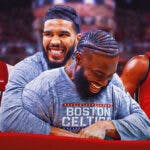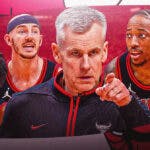Season Autopsies: San Antonio Spurs | Phoenix Suns | Dallas Mavericks | Sacramento Kings | Denver Nuggets | Milwaukee Bucks | Miami Heat | Minnesota Timberwolves
The Philadelphia 76ers mostly washed the Miami Heat in their first round matchup.
The brilliance of Aussie wunderkind Ben Simmons permeated the series. His very presence caused issues for which the Heat had no answer for. Joel Embiid was rusty, but he slammed the door defensively when Miami tried to pry it open with relentless drive-and-kick sequences. Hot shooting from Marco Belinelli, JJ Redick, Dario Saric, and Ersan Ilyasova further buried the Heat.
Miami fought — they always do. From Game 2 onward, Miami tried to muck up the game. Aggressive post fronts on Embiid led to approximately 382 fouls. Simmons took his fair share of shots inside of the paint. Philly's shooters didn't come off screens without getting touched.
Miami's “fight until you die, then fight in the afterlife” ethos is commendable — well, was commendable. Their fight was more proof the culture isn't just a talking point. It's real, and has been real since the Pat Riley Era kicked off in Miami over 20 years ago. But ultimately, it just didn't matter. A strong foundation — Heat culture — will raise your floor, but talent still reigns supreme. The Sixers had the two best players in the series by a wide margin and it showed in the result.
It was a predictable, yet disappointing end to a decent Heat season. They ebbed and flowed their way into 44 wins, though their profile was anything but encouraging. Miami remained a strong defensive unit (seventh in defensive rating), but their 20th-ranked offense held them back. The Heat barely broke even with a plus-0.5 net rating, the worst mark among playoff teams.
Injuries were a problem, and that certainly affected Miami's continuity. Still, a slight decline in the play of Goran Dragic and the, ahem, management of Hassan Whiteside exacerbated Miami's offensive woes. Those showed up big time during the playoffs.
Now, the Heat are in No Man's Land. They're a team full of solid players, but no star. A nice young core, but no piece that screams “I'll be top 20 in a couple of years.” That, combined with limited flexibility and draft picks makes their path to contention murky at best.
Setting the scene
To understand Miami's current position, we must go back to their 2016-17 campaign. Miami ended that season as one of the hottest teams in basketball. They started off 11-30 before literally flipping that record on its head and closing the year on a 30-11 run. Tiebreakers (and the Nets resting everyone in Game 82) blocked a playoff berth. Their unprecedented run still evoked praise from all over the league.
Head coach Erik Spoelstra pushed all the right buttons with his ragtag group. His attention to detail kept Miami in games they had no business hanging around in. He mixed and matched all sorts of lineups and found success. The Heat trotted out 11 different lineups for 40 or more minutes during their 30-11 hot streak. Nine of those were net positives despite featuring unknowns like Luke Babbitt, Willie Reed, and Rodney McGruder.
That run ultimately convinced the Heat to invest in what they had. Most notably, they retained Dion Waiters and James Johnson — journeymen that longed for stability and trust. The thinking was simple: run it back, hope for internal improvement, and compete
The Dion Waiters fallout
The decision to empower Waiters paid off the most. Waiters became a reliable secondary playmaker alongside Goran Dragic. The pairing was reminiscent of a running back duo. Dragic was the north-south runner that would get you to third-and-short situations. Waiters brought finesse — an ability to create something out of nothing.
His shining moment came against Golden State. With the game on the line and Klay Thompson in his path, Waiters shimmied his way into a send-em-home triple. A shot was made, a game was won, and a pose was immortalized
From January onward, Waiters averaged 16.7 points (41.6 percent from three on 5.1 attempts) and 4.6 assists while performing relatively well as an on-ball defender. The Heat went 22-8 (a 60-win pace) in those contests. Unfortunately, an ankle injury ended his season, and the Heat sputtered to the finish line without him.
Waiters' play and the importance of his archetype (shot creator) convinced the Heat to shell out a four-year deal. That bet, in a vacuum, was an understandable one. Locking him up while underestimating or ignoring the severity of the injury wasn't.
Waiters struggled on both ends of the floor this season. He made strides as a finisher (61.4 percent at the rim last season, 50.7 percent this season), but that came at significantly lower volume. His inability to get to the rim led to more contested looks. His overall efficiency nosedived. He moved poorly on defense, and the off-ball mental lapses that plagued him in other stops returned.
https://streamable.com/oquwj
Waiters was ultimately shut down for the year after undergoing surgery on his ankle. The jury is still out on if he'll be ready for the season opener. His recovery process puts the Heat in an impossible situation.
Logjam at guard
The Heat are loaded in the backcourt, though not in a great way. Waiters, Tyler Johnson, and Rodney McGruder all have cases for legitimate playing time. Wayne Ellington, arguably Miami's most important offensive weapon, hits free agency this summer. Josh Richardson thrived at small forward this year, but he's best suited at the 2.
Pat Riley just said that Josh Richardson is really a 2. Which means the roster has 3 2-guards on the roster (making a combined $43M) before Wade decides whether to play and the team decides whether to pay Ellington.
They need to balance the roster somehow. @5ReasonsSports
— Ethan J. Skolnick, 5 Reasons Sports (@EthanJSkolnick) April 30, 2018
In short, the Heat are heavy on guards but light on length. Flipping one of Johnson or Waiters for a legitimate small forward makes sense, but they'll be hard to move. Those two will combine to make over $31 million next season.
Johnson is steady on both ends, but he's more comfortable guarding point guards than bigger guards. Waiters fills a more pressing need offensively, but his ankle is concerning. You'd love for him to boost his value somehow, but should getting him involved be a bigger priority than expanding Richardson's usage?
That's a lot to consider before getting into McGruder, who was actually set to start at small forward before he got injured during the preseason. Ellington is a unique weapon coming off the best (volume three-point) shooting season in Heat history. Retaining him seems to be a priority, but an extension could push Miami into tax territory.
Oh, and that Wade guy may want to come back. He's only the greatest player in franchise history and served as Miami's most reliable clutch option in the playoffs.
There is a lot to juggle this offseason, to say the least.
The elephant in the room
The biggest question mark comes courtesy of Miami's biggest player. All of the following things about Hassan Whiteside are undoubtedly true:
- Whiteside is one of the most talented centers in the league. He's an elite finisher in pick-and-roll and a legitimate deterrent at the rim on the other end when he's engaged.
- The fact Whiteside needs to be prodded frustrates a lot of people, including his head coach.
- Whiteside improves and refines his skill set every year. He probably could've been utilized better this season.
- Screen setting and jostling for favorable positioning are longstanding issues for Whiteside and the fact that he doesn't “do his homework early” ultimately hurts his own case for more touches.
That's just a taste of the Whiteside debate. It is exhausting to hear, and even more frustrating to participate in. Trying to build around a “traditional” big in today's NBA is hard to do. When that player is paid as much as Whiteside is, you also kinda have to make it work.
Everyone has to take blame for Whiteside's odd season. Injuries disrupted his rhythm. Spoelstra didn't do a great job of putting him in position to succeed. Whiteside didn't put himself in position to succeed. The roster construction, namely the lack of a dynamic pick-and-roll guard (until the Wade trade, which, come on), made Whiteside's job harder.
Trading Whiteside is the easy suggestion — maybe even the right one. But that won't be easy in practice. The market for guys of his ilk is pretty spotty. Unless Miami wants 30 cents on the dollar, all three parties need to sit down and figure out how they can be successful together.
The Youth Movement
Miami's hope hinges on the young trio of Richardon, Justise Winslow, and Bam Adebayo. There isn't a surefire star in the mix but all three players project well in a league that values versatility. You won't find many young trios that can defend like these guys.
Richardson performed at an All-Defensive team level. Among 100 players that defended at least 700 field goal attempts, Richardson ranked fifth in opponent field goal percentage (41.6). He was one of four players to accumulate 100+ steals and 75+ blocks. Anthony Davis, Giannis Antetokounmpo, and Andre Drummond were the others.
There are plenty of highlights to choose from with Richardson, but this sequence is just a taste of what he brought this year:
https://streamable.com/6w914
Winslow looked out of sorts at times when playing the 4. But when he was able to switch across the perimeter, we saw many of the same flashes he showed during his rookie year. He's a near-perfect mix of mature and nasty:
Adebayo is the prototype for what teams want in a center in today's NBA. He has the length (7'3 wingspan) and instincts to toss shots at the rim. More importantly, he has the quickness and discipline to hold his own when switched out on the perimeter.
That's Adebayo stifling isolation attempts from LeBron James and Stephen Curry, two of the greatest offensive players ever.
Rookies aren't supposed to do that. Centers aren't supposed to do that. Rookie centers aren't supposed to do that. He must get stronger, but the foundation is there already.
Who makes The Leap?
Richardson probably has the best chance of going to the next level. The three-point stroke (37.8 percent on 4.1 attempts) normalized this year after a hot rookie year and a cold sophomore campaign. More importantly, he made serious strides as a creator. He's threading the needle on more pocket passes. Lefty scoop is his favorite finish at the rim. He comfortably stops-and-pops for rhythm jimmies at either elbow.
https://streamable.com/efkfh
Richardson didn't have many high volume games (let's say 15+ shot attempts), but the numbers were pretty impressive. In 10 such games, he averaged 20.5 points (46/44/88 shooting split), 4.4 rebounds, and 3.4 assists. That's pretty much in line with Khris Middleton's season averages, another young wing with an unlikely path to (pseudo) stardom.
Ten games is obviously too small of a sample size for meaningful projection, but the way Richardson trended with more reps is worth looking into. The defense is there. The shooting stroke is there. The game started slowing down for him in pick-and-roll as the year went on. He's become a better finisher. If he becomes more assertive and starts getting to the line (only 1.8 attempts this year), there's a path for Richardson to become Miami's top option. At least until Riley can work his magic and find his next superstar.




